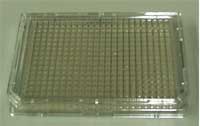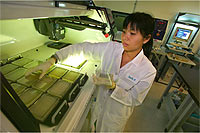
A 384-well culture stock plate.
Believe it or not, millions of copies of the DNA fragments are just not enough; we need billions! So each colony needs to be cultured again. This entails picking the good colonies from the agar plates and transferring each one to a well on a 384-well plate.
Instead of taking a chance that a technician might go blind picking colonies all day, we use a robot called the Genetix Q-Pix. JGI has four pickers that operate 24 hours a day. The robots’ imaging system can discriminate between white and blue colonies. Each colony is put into a separate well that contains 70 µl of a nutrient-rich liquid medium.

A technician loads plates into the colony picking machine.
All together, JGI can produce 500 384-well plates in a day (but we average 240). That’s 192,000 colonies! The plates are incubated for 18-20 hours at 37°C. After incubating, they can be stored at -80°C until they are ready for production sequencing.